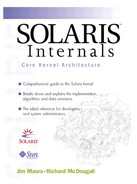1.4. Processes, Threads, and Scheduling
The Solaris kernel is multithreaded; that is, it is implemented with multiple threads of execution to allow concurrency across multiple processors. This architecture is a major departure from the traditional UNIX scheduling model. In Solaris, threads in the kernel, or kernel threads, are the fundamental unit that is scheduled and dispatched onto processors. Threads allow multiple streams of execution within a single virtual memory environment; consequently, switching execution between threads is inexpensive because no virtual memory context switch is required.
Threads are used for kernel-related tasks, for process execution, and for interrupt handling. Within the kernel, multiple threads of execution share the kernel's environment. Processes also contain one or more threads, which share the virtual memory environment of the process.
A process is an abstraction that contains the environment for a user program. It consists of a virtual memory environment, resources for the program such as an open file list, and at least one thread of execution. The virtual memory environment, open file list, and other components of the process environment are shared by the threads within each process.
Within each process is a lightweight process, a virtual execution environment for each kernel thread within a process. The lightweight process allows each kernel thread within a process to make system calls independently of other kernel threads within the same process. Without a lightweight process, only one system call could be made at a time. Each time a system call is made by a thread, its registers are placed on a stack within the lightweight process. Upon return from a system call, the system call return codes are placed in the lightweight process. Figure 1.3 shows the relationship between kernel threads, processes, and lightweight processes.
Figure 1.3. Kernel Threads, Processes, and Lightweight Processes

1.4.1. Two-Level Thread Model
Although it is relatively inexpensive to switch between multiple threads within a process, it is still relatively expensive to create and destroy threads. In addition, each kernel thread within a process requires a lightweight process containing a stack that consumes kernel resources. For these reasons, an additional level of thread management is implemented within each process to manage user threads, as shown in Figure 1.4.
Figure 1.4. Two-Level Thread Model

Solaris exposes user threads as the primary thread abstraction for multithreaded programs. User threads are implemented in a thread library and can be created and destroyed without kernel involvement. User threads are scheduled on and off the lightweight processes. As a result, only a subset of the user threads is active at any one time—those threads that are scheduled onto the lightweight processes. The number of lightweight processes within the process affects the degree of parallelism available to the user threads and is adjusted on-the-fly by the user thread library
1.4.2. Global Process Priorities and Scheduling
The Solaris kernel implements a global thread priority model for kernel threads. The kernel scheduler, or dispatcher, uses the model to select which kernel thread of potentially many runnable kernel threads executes next. The kernel supports the notion of preemption, allowing a better-priority thread to cause the preemption of a running thread, such that the better- (higher) priority thread can execute. The kernel itself is preemptable, an innovation providing for time-critical scheduling of high-priority threads. There are 170 global priorities; numerically larger priority values correspond to better thread priorities. The priority name space is partitioned by different scheduling classes, as illustrated in Figure 1.5.
Figure 1.5. Global Thread Priorities

The Solaris dispatcher implements multiple scheduling classes, which allow different scheduling policies to be applied to threads. The three primary scheduling classes—TS (IA is an enhanced TS), SYS, and RT—shown in Figure 1.5 are described below.
TS — The timeshare scheduling class is the default class for processes and all the kernel threads within the process. It changes process priorities dynamically according to recent processor usage in an attempt to evenly allocate processor resources among the kernel threads in the system. Process priorities and time quantums are calculated according to a timeshare scheduling table at each clock tick, or during wakeup after sleeping for an I/O. The TS class uses priority ranges 0 to 59.
IA — The interactive class is an enhanced TS class used by the desktop windowing system to boost priority of threads within the window under focus. IA shares the priority numeric range with the TS class.
SYS — The system class is used by the kernel for kernel threads. Threads in the system class are bound threads; that is, there is no time quantum—they run until they block. The system class uses priorities 60 to 99.
RT — The realtime class implements fixed priority, fixed time quantum scheduling. The realtime class uses priorities 100 to 159. Note that threads in the RT class have a higher priority over kernel threads in the SYS class.
The interrupt priority levels shown in Figure 1.5 are not available for use by anything other than interrupt threads. The intent of their positioning in the priority scheme is to guarantee that interrupt threads have priority over all other threads in the system.
